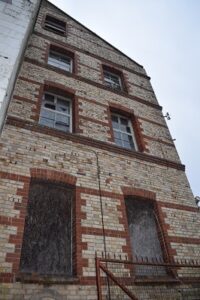By AB Heritage
Listed Building Consent is generally required for works of demolition, alteration or extension to a Listed Building that affect its character as a building of special architectural or historic interest. It can apply to internal as well as external features. This blog provides a quick overview of the process, with links to useful further resources.
The Listed Building Consent Application (LBC) Process
Your Local Planning authority administers the process of Listed Building Consent (LBC) overseen by their appointed Conservation Officer. AB Heritage advises clients to make a pre-application enquiry with their local planning team and Conservation Officers at the earliest stage, and certainly before completing an LBC application. A Heritage Statement will often be required for submission with the LBC application, so discussing this report with your heritage consultant could be beneficial.
Advice and guidance on the LBC process is available on the government’s planning portal, or from your LPA. Local authorities aim to complete the process within eight weeks, and this should include a statutory 21-day consultation period for neighbours and interested relevant parties. As part of this, experts from Historic England may be asked for advice, where the application involves a Grade I or Grade II* Listed Building, or the demolition, extensive works on key features, or particularly complex works on any grade of Listed Building.
What Works are Permissible within a Listed Building Development?
Every project to repair, refurbish or regenerate a Listed Building is unique and therefore the permissions required will vary. In addition, LPAs may have specific policies to protect regional characteristics and conservation officers may have different opinions when it comes to what is and is not permissible, including the extent of works needed.
istoric England publishes downloadable guidance on changes you can make to your historic property. Remember, Listed status will cover the internal and external features of a building, including: its structural elements, decorative features and fixtures, fabric and materials.

Things needing consent might include the replacement of windows or doors, moving or removing internal walls, painting brickwork or stone, or changing fireplaces, for example.
The key to gaining Listed Building Consent is the careful consideration of the ‘desirability of preserving the building, its setting and any features that make it special.’ The process to understanding the key significance of a building can be made easier by engaging a professional heritage consultant early, to help to clarify what features and characteristics are historically significant or not and, most importantly, why. They can also act on your behalf with the LPA officers and other stakeholders to negotiate on your behalf, helping progress the consent through the system.
What Happens if your LPA refuses Your Listed Building Consent Application?
If consent is refused, you have six months in which you can appeal to the Planning Inspectorate. If you did not engage a Heritage Consultant for your LBC, now would be a suitable time to reconsider, as they will be able to assist you understand your LPAs objections and help you amend your plans, to allow you to re-apply.
Works Undertaken Without Consent
Conducting unauthorised works to a Listed Building is a criminal offence, for which you could face prosecution. Purchasing a property without Listed Building planning consents in place for works undertaken is also problematic to say the least, as any new owner will inherit the responsibility and liability for such works. There is no guarantee that works will be granted retrospective consent, and prosecution may still take place. Finally, a Planning Authority can insist that all unconsented work is reversed, at the owners cost.
Where can you go for advice and guidance?
As previously mentioned, there are reliable sources of information and guidance for your own research. These include: The Government’s Planning Portal; Your Local Planning Authority Conservation Officer; Historic England’s library of downloadable guides; The Chartered Institute for Archaeologists (the organisation that oversees commercial archaeology and heritage consultancy in the UK); and the Institute for Historic Building Conservation (IHBC). There are also membership organisations such as The Listed Property Owners Club, who publish print and online resources.
Finally, seeking advice from a professionally registered Heritage Consultant’s like AB Heritage Limited, at an early stage of your project, can help you to understand the historic significance of your property, prepare plans that are more likely to achieve planning consent and provide advocacy with heritage stakeholders.
AB Heritage is a Registered Archaeological Organisation with the Chartered Institute for Archaeologists, with a number of Heritage Consultants who are accredited with the Institute of Historic Building Conservation.
The post A Quick Guide to Applying for a Listed Building Consent appeared first on Built Environment Networking.

